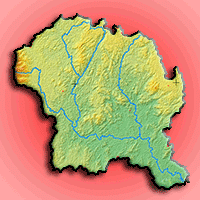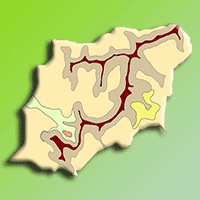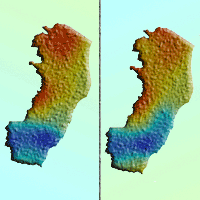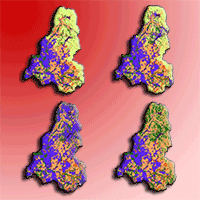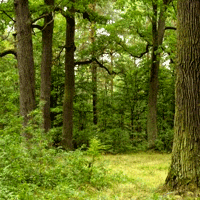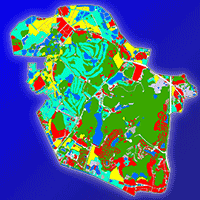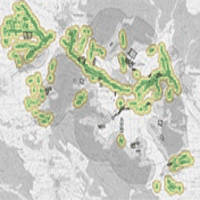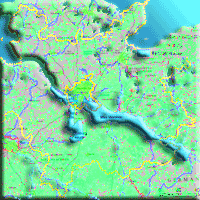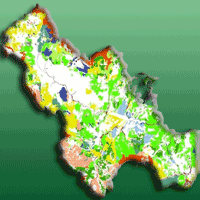We propose a method to classify priority sites for Atlantic Rainforest restoration aiming to increase basin streamflows. The Rainfall Forest to Water Production (RFWP) method uses multicriteria analysis supported by GIS techniques and hydrological modeling. The method was applied to the Itapemirim River Basin, southeastern Brazil. The application of RFWP provided a map of areas with different priority for forest restoration by overlapping standardized numerical criteria with different weights (climatological, soil type/land use, and relief). The results indicated the influence of the wide distribution of the restoration sites on the streamflows. The RFWP proved to be suitable for the spatial analysis of the effect of different restoring areas on streamflows. Based on simulated scenarios, an increase in the native forest cover by restoration up to 27.6% of the basin area is expected to significantly enhance water production. The priority areas where forest restoration could better contribute to increase streamflows were delineated, especially at high altitude and in pastures, which are mostly in degraded conditions.
Keywords
, , ,
Citation
Cecílio RA, Oliveira-Ravani LT, Zanetti SS, Mendes HA (2021). Method for classifying sites to Atlantic Rainforest restoration aiming to increase basin’s streamflows. iForest 14: 86-94. - doi: 10.3832/ifor3658-013
Academic Editor
Carlotta Ferrara
Paper history
Received: Sep 22, 2020
Accepted: Dec 18, 2020
First online: Feb 19, 2021
Publication Date: Feb 28, 2021
Publication Time: 2.10 months
© SISEF - The Italian Society of Silviculture and Forest Ecology 2021
Open Access
This article is distributed under the terms of the Creative Commons Attribution-Non Commercial 4.0 International (https://creativecommons.org/licenses/by-nc/4.0/), which permits unrestricted use, distribution, and reproduction in any medium, provided you give appropriate credit to the original author(s) and the source, provide a link to the Creative Commons license, and indicate if changes were made.

Breakdown by View Type
(Waiting for server response...)
Article Usage
Total Article Views: 35119
(from publication date up to now)
Breakdown by View Type
HTML Page Views: 30156
Abstract Page Views: 2217
PDF Downloads: 2194
Citation/Reference Downloads: 0
XML Downloads: 552
Web Metrics
Days since publication: 1781
Overall contacts: 35119
Avg. contacts per week: 138.03
Article Citations
Article citations are based on data periodically collected from the Clarivate Web of Science web site
(last update: Mar 2025)
Total number of cites (since 2021): 2
Average cites per year: 0.40
Publication Metrics
by Dimensions ©
Articles citing this article
List of the papers citing this article based on CrossRef Cited-by.
(1)
Alvarenga LA, Mello CR, Colombo A, Cuartas LA (2017)Hydrologic impacts due to the changes in riparian buffer in a headwater watershed. CERNE 23: 95-102.
CrossRef |
Gscholar
(2)
Alves BJR, Madari BE, Boddey RM (2017)Integrated crop-livestock-forestry systems: prospects for a sustainable agricultural intensification. Nutrient Cycling in Agroecosystems 108: 1-4.
CrossRef |
Gscholar
(3)
Bennett BM, Barton GA (2018)The enduring link between forest cover and rainfall: a historical perspective on science and policy discussions. Forest Ecosystems 5: 5.
CrossRef |
Gscholar
(4)
Beyer M, Hamutoko JT, Wanke H, Gaj M, Koeniger P (2018)Examination of deep root water uptake using anomalies of soil water stable isotopes, depth-controlled isotopic labeling and mixing models. Journal of Hydrology 566: 122-136.
CrossRef |
Gscholar
(5)
Bonilla Valverde J, Blank C, Roidt M, Schneider L, Stefan C (2016)Application of a GIS multi-criteria decision analysis for the identification of intrinsic suitable sites in Costa Rica for the application of managed aquifer recharge (MAR) through spreading methods. Water 8: 391.
CrossRef |
Gscholar
(6)
Bressiani JX, Schmidt MAR (2016)Proposta de uso das áreas variáveis de afluência como área de proteção permanente [Use proposition of the variable source areas as permanent protection area]. Revista Monografias Ambientais 15: 198-208. [in Portuguese]
CrossRef |
Gscholar
(7)
Brogna D, Vincke C, Brostaux Y, Soyeurt H, Dufrêne M, Dendoncker N (2017)How does forest cover impact water flows and ecosystem services? Insights from “real-life” catchments in Wallonia (Belgium). Ecological Indicators 72: 675-685.
CrossRef |
Gscholar
(8)
Bruijnzeel LA (2004)Hydrological functions of tropical forests: not seeing the soil for the trees? Agriculture, Ecosystems and Environment 104: 185-228.
CrossRef |
Gscholar
(9)
Campos I, Balbontín C, González-Piqueras J, González-Dugo MP, Neale CMU, Calera A (2016)Combining a water balance model with evapotranspiration measurements to estimate total available soil water in irrigated and rainfed vineyards. Agricultural Water Management 165: 141-152.
CrossRef |
Gscholar
(10)
Castro DFS, Pezzopane JRM, Cecílio RA, Pezzopane JEM (2010)Uso de imagens de radas para a espacilização da temperatura do ar [Use of radar images to estimate air temperature]. Idesia (Arica) 28: 69-79. [in Portuguese]
CrossRef |
Gscholar
(11)
Cecílio RA, Campanharo WA, Zanetti SS, Lehr AT, Lopes AC (2020)Hydrological modelling of tropical watersheds under low data availability. Research, Society and Development 9: e1009 53262.
CrossRef |
Gscholar
(12)
Conrad O, Bechtel B, Bock M, Dietrich H, Fischer E, Gerlitz L, Wehberg J, Wichmann V, Böhner J (2015)System for Automated Geoscientific Analyses (SAGA) v.2.1.4. Geoscientific Model Development 8: 1991-2007.
CrossRef |
Gscholar
(13)
Cooper M, Medeiros JC, Rosa JD, Soria JE, Toma RS (2013)Soil functioning in a toposequence under rainforest in São Paulo, Brazil. Revista Brasileira de Ciência do Solo 37: 392-399.
CrossRef |
Gscholar
(14)
Costa CR, Da Costa MF, Barletta M, Alves LHB (2017)Interannual water quality changes at the head of a tropical estuary. Environmental Monitoring and Assessment. 189: 628.
CrossRef |
Gscholar
(15)
Cristan R, Aust WM, Bolding MC, Barrett SM, Munsell JF, Schilling E (2016)Effectiveness of forestry best management practices in the United States: literature review. Forest Ecology and Management 360: 133-151.
CrossRef |
Gscholar
(16)
Dean JF, Webb JA, Jacobsen GE, Chisari R, Dresel PE (2015)A groundwater recharge perspective on locating tree plantations within low-rainfall catchments to limit water resource losses. Hydrology and Earth System Sciences 19: 1107-1123.
CrossRef |
Gscholar
(17)
Drover DR, Jackson CR, Bitew M, Du E (2015)Effects of DEM scale on the spatial distribution of the TOPMODEL topographic wetness index and its correlations to watershed characteristics. Hydrology and Earth System Sciences Discussions 12: 11817-11846.
CrossRef |
Gscholar
(18)
Ediriweera S, Danaher T, Pathirana S (2016)The influence of topographic variation on forest structure in two woody plant communities: a remote sensing approach. Forest Systems 25: 1-11.
Online |
Gscholar
(19)
Ellison D, Morris CE, Locatelli B, Sheil D, Cohen J, Murdiyarso D, Gutierrez V, Van Noordwijk M, Creed IF, Pokorny J, Gaveau D, Spracklen DV, Tobella AB, Ilstedt U, Teuling AJ, Gebrehiwot SG, Sands DC, Muys B, Verbist B, Springgay E, Sugandi Y, Sullivan CA (2017)Trees, forests and water: cool insights for a hot world. Global Environmental Change 43: 51-61.
CrossRef |
Gscholar
(20)
Ferraz SFB, Lima WP, Rodrigues CB (2013)Managing forest plantation landscapes for water conservation. Forest Ecology and Management 301: 58-66.
CrossRef |
Gscholar
(21)
Filoso S, Bezerra MO, Weiss KCB, Palmer MA (2017)Impacts of forest restoration on water yield: a systematic review. PLoS One 12: e018 3210.
CrossRef |
Gscholar
(22)
Foulon E, Rousseau AN, Gagnon P (2018)Development of a methodology to assess future trends in low flows at the watershed scale using solely climate data. Journal of Hydrology 557: 774-790.
CrossRef |
Gscholar
(23)
GEOBASES (2015)Sistema integrado de bases geoespaciais do Estado do Espírito Santo [Integrated system of geospatial bases of the State of Espírito Santo]. Vitória, Brazil. [in Portuguese]
Online |
Gscholar
(24)
Gribovszki Z, Kalicz P, Balog K, Szabó A, Tóth T, Csáfordi P, Metwaly M, Szalai S (2017)Groundwater uptake of different surface cover and its consequences in great Hungarian plain. Ecological Processes 6: 39.
CrossRef |
Gscholar
(25)
Ilstedt U, Bargués Tobella A, Bazié HR, Bayala J, Verbeeten E, Nyberg G, Sanou J, Benegas L, Murdiyarso D, Laudon H, Sheil D, Malmer A (2016)Intermediate tree cover can maximize groundwater recharge in the seasonally dry tropics. Scientific Reports 6: 21930.
CrossRef |
Gscholar
(26)
Kim Y-S, Latifah S, Afifi M, Mulligan M, Burke S, Fisher L, Siwicka E, Remoundou K, Christie M, Masek Lopez S, Jenness J (2018)Managing forests for global and local ecosystem services: a case study of carbon, water and livelihoods from eastern Indonesia. Ecosystem Services 31: 153-168.
CrossRef |
Gscholar
(27)
Lamb D (2018)Undertaking large-scale forest restoration to generate ecosystem services. Restoration Ecology 26: 657-666.
CrossRef |
Gscholar
(28)
Leal MS, Mingoti R, Dias HCT, Ferreira MP, Tonello KC (2019)Definition of priority areas for soil and water conservation in the Itanguá watershed, Capão Bonito, SP state, Brazil. Ciência Florestal 29: 531.
CrossRef |
Gscholar
(29)
Liang W-L, Chan M-C (2017)Spatial and temporal variations in the effects of soil depth and topographic wetness index of bedrock topography on subsurface saturation generation in a steep natural forested headwater catchment. Journal of Hydrology 546: 405-418.
CrossRef |
Gscholar
(30)
Lima DWP, Laprovitera R, Ferraz DSFB, Rodrigues CB, Silva MM (2012)Forest plantations and water consumption: a strategy for hydrosolidarity. International Journal of Forestry Research 2012: 1-8.
CrossRef |
Gscholar
(31)
Lozano-Baez SE, Cooper M, Ferraz SFB, Ribeiro Rodrigues R, Pirastru M, Di Prima S (2018)Previous land use affects the recovery of soil hydraulic properties after forest restoration. Water 10: 453.
CrossRef |
Gscholar
(32)
Lozano-Baez SE, Cooper M, Meli P, Ferraz SFB, Rodrigues RR, Sauer TJ (2019)Land restoration by tree planting in the tropics and subtropics improves soil infiltration, but some critical gaps still hinder conclusive results. Forest Ecology and Management 444: 89-95.
CrossRef |
Gscholar
(33)
Malczewski J, Rinner C (2015)Multicriteria decision analysis in geographic information science (1st edn). Springer Berlin Heidelberg, Berlin, Heidelberg, pp. 143.
CrossRef |
Gscholar
(34)
Mello DK, Costa DDR, Valente RA, Vettorazzi CA (2018)Multicriteria evaluation for protected area definition aiming at water quality improvement. Floresta e Ambiente. 25.
CrossRef |
Gscholar
(35)
Mendes HA, Cecílio RA, Zanetti SS (2020)Influence of soil depth and spatial resolution on the performance of the DHSVM hydrological model in basins with low input data availability. Journal of South American Earth Sciences 102993.
CrossRef |
Gscholar
(36)
Mendes NGS, Cecílio RA, Zanetti SS (2018)Forest coverage and streamflow of watersheds in the Tropical Atlantic Rainforest. Revista Árvore 42: 2-10.
CrossRef |
Gscholar
(37)
Morellato LPC, Haddad CFB (2000)Introduction: the Brazilian Atlantic Forest. Biotropica 32: 786-792.
CrossRef |
Gscholar
(38)
Móricz N, Tóth T, Balog K, Szabó A, Rasztovits E, Gribovszki Z (2016)Groundwater uptake of forest and agricultural land covers in regions of recharge and discharge. iForest - Biogeosciences and Forestry 9: 696-701.
CrossRef |
Gscholar
(39)
Oliveira PTS, Leite MB, Mattos T, Nearing MA, Scott RL, Xavier RDO, Matos DMDS, Wendland E (2016)Groundwater recharge decrease with increased vegetation density in the Brazilian cerrado. Ecohydrology 10 (1): e1759.
CrossRef |
Gscholar
(40)
Pham MT, Vernieuwe H, De Baets B, Verhoest NEC (2018)A coupled stochastic rainfall-evapotranspiration model for hydrological impact analysis. Hydrology and Earth System Sciences 22: 1263-1283.
CrossRef |
Gscholar
(41)
Rahman MA, Rusteberg B, Uddin MS, Lutz A, Saada MA, Sauter M (2013)An integrated study of spatial multicriteria analysis and mathematical modelling for managed aquifer recharge site suitability mapping and site ranking at Northern Gaza coastal aquifer. Journal of Environmental Management 124: 25-39.
CrossRef |
Gscholar
(42)
Rahmati O, Pourghasemi HR, Melesse AM (2016)Application of GIS-based data driven random forest and maximum entropy models for groundwater potential mapping: a case study at Mehran Region, Iran. Catena 137: 360-372.
CrossRef |
Gscholar
(43)
Rezende CL, Scarano FR, Assad ED, Joly CA, Metzger JP, Strassburg BBN, Tabarelli M, Fonseca GA, Mittermeier RA (2018)From hotspot to hopespot: An opportunity for the Brazilian Atlantic Forest. Perspectives in Ecology and Conservation 16: 208-214.
CrossRef |
Gscholar
(44)
Ribeiro MC, Metzger JP, Martensen AC, Ponzoni FJ, Hirota MM (2009)The Brazilian Atlantic forest: how much is left, and how is the remaining forest distributed? Implications for conservation. Biological Conservation 142: 1141-1153.
CrossRef |
Gscholar
(45)
Rocha Junior PR, Andrade FV, Mendonça EDS, Donagemma GK, Fernandes RBA, Bhattharai R, Kalita PK (2017)Soil, water, and nutrient losses from management alternatives for degraded pasture in Brazilian Atlantic Rainforest biome. Science of The Total Environment 583: 53-63.
CrossRef |
Gscholar
(46)
Saaty TL (1977)A scaling method for priorities in hierarchical structures. Journal of Mathematical Psychology 15: 234-281.
CrossRef |
Gscholar
(47)
Sartori A, Lombardi Neto F, Genovez AM (2005)Hydrologic classification of Brazilian soils to estimate excess rainfall using the soil conservation service method. Part 1: classification. Revista Brasileira de Recursos Hídricos 10: 5-18.
CrossRef |
Gscholar
(48)
Schneiderman EM, Steenhuis TS, Thongs DJ, Easton ZM, Zion MS, Neal AL, Mendoza GF, Todd Walter M (2007)Incorporating variable source area hydrology into a curve-number-based watershed model. Hydrological Processes 21: 3420-3430.
CrossRef |
Gscholar
(49)
Sheshukov AY, Sekaluvu L, Hutchinson SL (2018)Accuracy of topographic index models at identifying ephemeral gully trajectories on agricultural fields. Geomorphology 306: 224-234.
CrossRef |
Gscholar
(50)
Sørensen R, Zinko U, Seibert J (2006)On the calculation of the topographic wetness index: evaluation of different methods based on field observations. Hydrology and Earth System Sciences 10: 101-112.
CrossRef |
Gscholar
(51)
Souza CM, Shimbo Z J, Rosa MR, Parente LL, Alencar A A, Rudorff BFT, Hasenack H, Matsumoto M, Ferreira G L, Souza-Filho PWM, De Oliveira SW, Rocha WF, Fonseca AV, Marques CB, Diniz CG, Costa D, Monteiro D, Rosa ER, Vélez-Martin E, Weber EJ, Lenti FEB, Paternost FF, Pareyn FGC, Siqueira JV, Viera JL, Neto LCF, Saraiva MM, Sales MH, Salgado MPG, Vasconcelos R, Galano S, Mesquita VV, Azevedo T (2020)Reconstructing three decades of land use and land cover changes in Brazilian biomes with landsat archive and earth engine. Remote Sensing 12: 2735.
CrossRef |
Gscholar
(52)
Valente RA, Petean FCS, Vettorazzi CA (2017)Multicriteria decision analysis for prioritizing areas for forest restoration. Cerne 23: 53-60.
CrossRef |
Gscholar
(53)
Vettorazzi CA, Valente RA (2016)Priority areas for forest restoration aiming at the conservation of water resources. Ecological Engineering 94: 255-267.
CrossRef |
Gscholar
(54)
Wigmosta MS, Vail LW, Lettenmaier DP (1994)A distributed hydrology-vegetation model for complex terrain. Water Resources Research 30: 1665-1679.
CrossRef |
Gscholar
(55)
Wilson M, Lovell S (2016)Agroforestry - The next step in sustainable and resilient agriculture. Sustainability 8: 574.
CrossRef |
Gscholar
(56)
Xavier AC, King CW, Scanlon BR (2016)Daily gridded meteorological variables in Brazil (1980-2013). International Journal of Climatology 36: 2644-2659.
CrossRef |
Gscholar
(57)
Zanetti SS, Dohler RE, Cecílio RA, Pezzopane JEM, Xavier AC (2019)Proposal for the use of daily thermal amplitude for the calibration of the Hargreaves-Samani equation. Journal of Hydrology 571: 193-201.
CrossRef |
Gscholar
